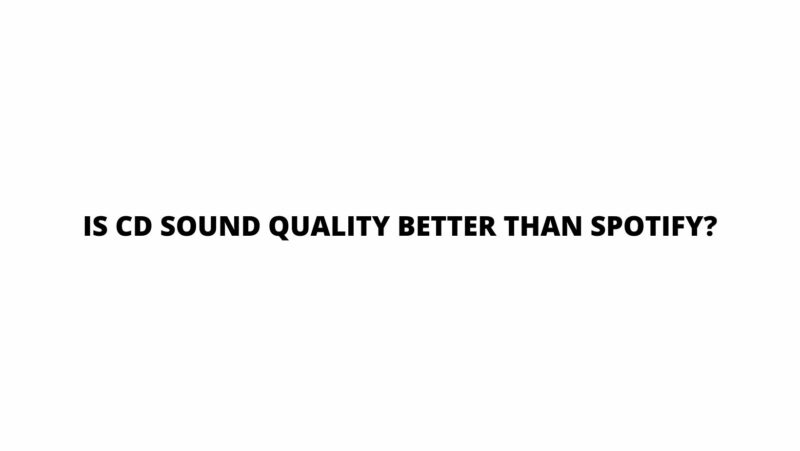The battle for auditory supremacy rages on as music enthusiasts weigh the virtues of Compact Disc (CD) sound quality against the convenience and ubiquity of Spotify streaming. In an era defined by digital innovation and music consumption at our fingertips, the question arises: Is CD sound quality truly superior to Spotify? This article delves into the technical underpinnings of both formats, exploring the intricacies of audio quality, the nuances of compression, and the subjective experience of listeners. By examining the qualities of CD sound and Spotify streaming, we aim to navigate the musical spectrum and shed light on the eternal debate of quality versus convenience.
CD Sound Quality: The Analog-Digital Nexus
Uncompressed Purity: CDs store audio in an uncompressed format with a bit depth of 16 bits and a sample rate of 44.1 kHz. This captures a wide range of frequencies and nuances, preserving the authenticity and integrity of the original recording.
Analog Warmth: Despite being a digital format, CDs often evoke an analog warmth that stems from the subtle imperfections introduced during the analog-to-digital conversion process. This warmth contributes to a sense of depth and emotional engagement with the music.
Dynamic Range: CDs offer a wide dynamic range, ensuring the faithful representation of both the softest whispers and the loudest crescendos. This dynamic prowess enriches the listening experience, immersing the listener in the full spectrum of sonic intensity.
Spotify Sound Quality: Streaming Revolution
Audio Compression: Spotify employs audio compression algorithms, such as Ogg Vorbis, to reduce the size of audio files for streaming. This compression is necessary for efficient data transmission but can lead to audio quality compromises.
Bitrates and Quality: Spotify offers different levels of audio quality, ranging from the Free tier’s 160 kbps to the Premium tier’s 320 kbps. Higher bitrates generally translate to better audio quality, as they preserve more of the original audio data.
Streaming Convenience: Spotify’s key allure lies in its convenience—access to an immense library of songs across various devices and platforms. This accessibility has redefined how we consume music, offering a seamless transition between different moods and settings.
The Quality Conundrum: CD vs. Spotify
Audio Fidelity: The central argument in the CD vs. Spotify debate revolves around audio fidelity. CDs, with their uncompressed format, offer superior audio quality that captures the intricacies of the original recording. In contrast, Spotify’s compression introduces artifacts that can diminish the richness and depth of the music.
Perceptual Nuances: While the technical differences between CD and Spotify audio quality are distinguishable, the perceptual nuances vary among listeners. Audiophiles and individuals with high-end audio equipment might more readily discern these differences, whereas casual listeners might find the distinctions less pronounced.
Listening Environment and Equipment: The quality of headphones or speakers, as well as the listening environment, play crucial roles in the perception of audio quality. High-end equipment and controlled listening spaces enhance the potential to identify the differences between CD and Spotify sound.
Musical Genres: The genre of music being listened to can influence the perception of differences. Complex genres with intricate layering and dynamic ranges might reveal more pronounced differences, while simpler genres might not.
Audiophiles vs. Casual Listeners
Audiophile Perspective: Audiophiles, who prioritize audio quality and invest in high-end equipment, tend to lean towards CD sound quality. For them, the subtle nuances and authenticity of CDs resonate on a deep level.
Casual Listener Perspective: Casual listeners often prioritize convenience and accessibility over slight differences in audio quality. The convenience of Spotify’s streaming model often outweighs the pursuit of audiophile-level sound.
Conclusion: A Harmonious Blend
The question of whether CD sound quality is better than Spotify is ultimately subjective and multifaceted. The appreciation of audio quality extends beyond mere technical specifications—it’s a fusion of personal preference, listening habits, equipment, and context.
CD sound quality is lauded for its authenticity, uncompressed nature, and analog warmth. It appeals to those who seek a richer, more immersive listening experience. On the other hand, Spotify offers unparalleled convenience, making it the go-to choice for on-the-go music consumption.
The decision between CD and Spotify ultimately hinges on what one values most. Audiophiles might gravitate toward the pure sound of CDs, while casual listeners might embrace the versatility and accessibility of Spotify. As technology continues to advance, both formats are here to stay, harmoniously coexisting to cater to a diverse spectrum of music lovers.

